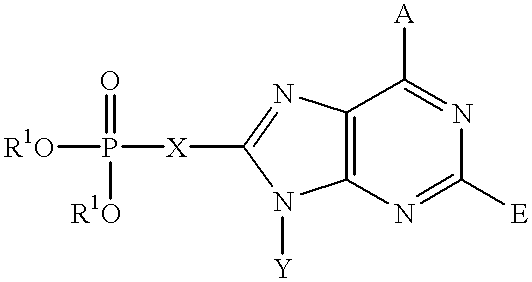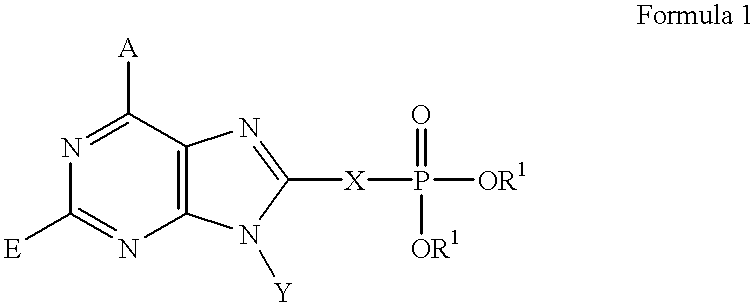Purine inhibitors of fructose 1,6-bisphosphatase
a technology of fructose and inhibitors, which is applied in the direction of biocide, drug composition, metabolic disorders, etc., can solve the problems of limiting the overall success of the treatment, affecting the treatment effect of niddm patients, and a large segment of the niddm population that does not respond adequately to sulfonylurea therapy
- Summary
- Abstract
- Description
- Claims
- Application Information
AI Technical Summary
Benefits of technology
Problems solved by technology
Method used
Image
Examples
example 1
Preparation of 5-diethylphosphono-2-furaldehyde (1)
Step A. A solution of 2-furaldehyde diethyl acetal (1 mmol) in THF was treated with nBuLi (1 mmol) at -78.degree. C. After 1 h, diethyl chlorophosphate (1.2 mmol) was added and the reaction was stirred for 40 min. Extraction and evaporation gave a brown oil.
Step B. The resulting brown oil was treated with 80% acetic acid at 90.degree. C. for 4 h. Extraction and chromatography gave compound 1 as a clear yellow oil.
Alternatively this aldehyde can be prepared from furan as described below.
Step C. A solution of furan (1 mmol) in diethyl ether was treated with TMEDA (N,N,N'N'-tetramethylethylenediamine) (1 mmol) and nBuLi (2 mmol) at -78.degree. C. The solution was stirred for 0.5 h. at -78.degree. C. and diethyl chlorophosphate was added and stirred for another 1 h. Extraction and distillation produced diethyl 2-furanphosphonate as a clear oil.
Step D. A solution of diethyl 2-furanphosphonate (1 mmol) in THF (tetrahydrofuran) was treated...
example 2
Preparation of N.sup.9 -substituted-8-(2-(5-phosphono)furanyl)adenines
The preparation of N.sup.9 -(2-phenethyl)-8-(2-(5-phosphono)furanyl)adenine is given as an example:
Step A. A solution of 5-amino-4,6-dichloropyrimidine (1 mmol) in nBuOH was treated with Et.sub.3 N (1.2 mmol) and phenethylamine (1.05 mmol) at 80.degree. C. After 12 h, the cooled reaction mixture was evaporated under vacuum and the residue was chromatographed to give 6-chloro-5-amino-4-(phenethylamino)-pyrimidine as a yellow solid. mp 156-157.degree. C.; TLC: R.sub.f =0.41, 50% EtOAc-hexane.
Step B. The 6-chloro-5-amino-4-(2-phenethylamino)pyrimidine (1 mmol) in DMSO was treated with 2-furaldehyde (1.5 mmol) and FeCl.sub.3 -silica (2.0 mmol) at 80.degree. C. After 12 h, the cooled reaction mixture was filtered and the filtrate was evaporated under vacuum. Chromatography afforded 6-chloro-N.sup.9 -(2-phenethyl)-8-(2-furanyl)purine as a yellow solid. TLC: Rf=0.62, 50% EtOAc-hexane. Anal. calcd. for C.sub.17 H.sub.13 N...
examples 3
Preparation of N.sup.9 -substituted-8-(2-phosphonoethylamino)adenines
Step A. Adenine (1 mmol) in DMF was treated with sodium hydride (1.2 mmol) followed by benzyl bromide (1.2 mmol) at room temperature under nitrogen. The resulting mixture was warmed at 100.degree. C. for 2 h. The cooled reaction mixture was evaporated to dryness. Extraction and chromatography afforded N.sup.9 -benzyladenine.
Step B. A solution of N.sup.9 -benzyladenine (1 mmol) in acetic acid buffer (pH=4) was treated with bromine (1 mmol) at room temperature for 12 h. The reaction was quenched with 10% sodium sulfite solution and extracted with dichloromethane. The combined extracts were dried (Na.sub.2 SO.sub.4) and evaporated to dryness. Chromatography afforded N.sup.9 -benzyl-8-bromoadenine.
Step C. A mixture of N.sup.9 -benzyl-8-bromoadenine (1 mmol), aminoethylphosphonate (2 mmol), and sodium hydroxide (2 mmol) in ethanol-water in a sealed tube was warmed at 110.degree. C. under nitrogen. After 24 h the cooled ...
PUM
| Property | Measurement | Unit |
|---|---|---|
| Molar density | aaaaa | aaaaa |
| Molar density | aaaaa | aaaaa |
| Molar density | aaaaa | aaaaa |
Abstract
Description
Claims
Application Information
 Login to View More
Login to View More - R&D
- Intellectual Property
- Life Sciences
- Materials
- Tech Scout
- Unparalleled Data Quality
- Higher Quality Content
- 60% Fewer Hallucinations
Browse by: Latest US Patents, China's latest patents, Technical Efficacy Thesaurus, Application Domain, Technology Topic, Popular Technical Reports.
© 2025 PatSnap. All rights reserved.Legal|Privacy policy|Modern Slavery Act Transparency Statement|Sitemap|About US| Contact US: help@patsnap.com



